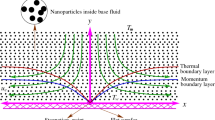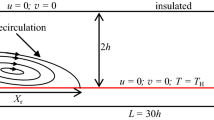Abstract
In this paper, a non-isobaric Marangoni boundary layer flow that can be formed along the interface of immiscible nanofluids in surface driven flows due to an imposed temperature gradient, is considered. The solution is determined using a similarity solution for both the momentum and energy equations and assuming developing boundary layer flow along the interface of the immiscible nanofluids. The resulting system of nonlinear ordinary differential equations is solved numerically using the shooting method along with the Runge-Kutta-Fehlberg method. Numerical results are obtained for the interface velocity, the surface temperature gradient as well as the velocity and temperature profiles for some values of the governing parameters, namely the nanoparticle volume fraction φ (0≤φ≤0.2) and the constant exponent β. Three different types of nanoparticles, namely Cu, Al2O3 and TiO2 are considered by using water-based fluid with Prandtl number Pr =6.2. It was found that nanoparticles with low thermal conductivity, TiO2, have better enhancement on heat transfer compared to Al2O3 and Cu. The results also indicate that dual solutions exist when β<0.5. The paper complements also the work by Golia and Viviani (Meccanica 21:200–204, 1986) concerning the dual solutions in the case of adverse pressure gradient.
Similar content being viewed by others
Abbreviations
- C p :
-
specific heat at constant pressure
- (ρ C p )nf :
-
heat capacitance of the nanofluid
- f(η):
-
dimensionless stream function
- g(η):
-
dimensionless thermal function
- h 0 :
-
constant in (8)
- k :
-
thermal conductivity
- k nf :
-
thermal conductivity of the nanofluid
- l 0 :
-
constant in (8)
- Pr :
-
Prandtl number
- t 0 :
-
constant in (7)
- T :
-
dimensionless temperature of the nanofluid
- T e :
-
constant temperature of the free stream flow
- T 0(x):
-
interface temperature distribution
- u,v :
-
velocity components along x and y directions, respectively
- u e (x):
-
free stream velocity or velocity of the external flow
- u 0 :
-
constant in (7)
- x,y :
-
Cartesian coordinates measured along the interface and normal to it, respectively
- α nf :
-
thermal diffusivity of the nanofluid
- β :
-
constant exponent
- γ :
-
temperature coefficient of surface tension
- μ nf :
-
effective viscosity of the nanofluid
- φ :
-
nanoparticle volume fraction
- η :
-
similarity variable
- ρ :
-
density
- ρ nf :
-
effective density of the nanofluid
- σ :
-
surface tension
- σ 0 :
-
constants surface tension at origin
- f :
-
fluid fraction
- s :
-
solid fraction
References
Levich VG (1962) Physicochemical hydrodynamics. Prentice-Hall, Englewood Cliffs
Sawistowski H (1971) Interfacial phenomena. In: Hanson C (ed) Recent advances in liquid–liquid extraction. Oxford, Pergamon, pp 293–366
Daniel S, Chaudhury MK, Chen JC (2001) Fast drop movements resulting from the phase change on a gradient surface. Science 291:633–636
Daniel S, Sircar S, Gliem J, Chaudhury MK (2004) Ratcheting motion of liquid drops on gradient surfaces. Langmuir 20:4085–4092
Colegate DM, Bain CD (2005) Adsorption kinetic in micellar solutions of nonionic surfactant. Phys Rev Lett 95:198302
Weiss M, Darton CR, Battal T, Bain CD (2006) Surfactant adsorption and Marangoni flow in liquid jets. 3. Modeling in the presence of micellar surfactant. Ind Eng Chem Res 45:2235–2248
Bahadur P, Yadav PS, Chaurasia K, Leh A, Tadmor R (2009) Chasing drops: Following escaper and pursuer drop couple system. J Colloid Interface Sci 332:455–460
Sternling CV, Scriven LE (1959) Interfacial turbulence: hydrodynamic instability and the Marangoni effect. AIChE J 5:514–523
Tadmor R (2009) Marangoni flow revisited. J Colloid Interface Sci 332:451–454
Bird BR, Stewart W, Lightfoot EN (2002) Transport phenomena, 2nd edn. Wiley, New York
Magyari E, Chamkha AJ (2008) Exact analytical results for the thermosolutal MHD Marangoni boundary layers. Int J Therm Sci 47:848–857
Napolitano LG (1978) Microgravity fluid dynamics. In: 2nd Levitch conference, Washington
Napolitano LG (1979) Marangoni boundary layers. In: Proc. 3rd European symposium on material science in space, Grenoble, ESA SP-142
Eyer A, Leist H, Nitsche R (1985) Floating zone growth of silicon under microgravity in sounding rocket. J Cryst Growth 71:173–182
Christopher DM, Wang B (2001) Prandtl number effects for Marangoni convection over a flat surface. Int J Therm Sci 40:564–570
Napolitano LG (1982) Surface and buoyancy driven free convection. Acta Astronaut 9:199–215
Napolitano LG, Golia C (1981) Coupled Marangoni boundary layers. Acta Astronaut 8:417–434
Napolitano LG, Russo G (1984) Similar axially symmetric Marangoni boundary layers. Acta Astronaut 11:189–198
Golia C, Viviani A (1985) Marangoni buoyant boundary layers. Aerotec Missili Spaz 64:29–35
Golia C, Viviani A (1986) Non isobaric boundary layers related to Marangoni flows. Meccanica 21:200–204
Napolitano LG, Carlomagno GM, Vigo P (1977) New classes of similar solutions for laminar free convection problems. Int J Heat Mass Transf 20:215–226
Pop I, Postelnicu A, Grosan T (2001) Thermosolutal Marangoni forced convection boundary layers. Meccanica 36:555–571
Chamkha AJ, Pop I, Takhar HS (2006) Marangoni mixed convection boundary layerflow. Meccanica 41:219–232
Trisaksri V, Wongwises S (2007) Critical review of heat transfer characteristics of nanofluids. Renew Sustain Energy Rev 11:512–523
Godson L, Raja B, Lal DM, Wongwises S (2010) Enhancement of heat transfer using nanofluid—An overview. Renew Sustain Energy Rev 14:629–641
Choi SUS (1995) Enhancing thermal conductivity of fluids with nanoparticles. In: The proc 1995 ASME int mech eng congress and exposition, San Francisco, USA, ASME, FED vol 231/MD 66, pp 99–105
Das SK, Choi SUS, Yu W, Pradeep T (2007) Nanofluids: Science and technology. Wiley, New Jersey
Buongiorno J (2006) Convective transport in nanofluids. ASME J Heat Transf 128:240–250
Daungthongsuk W, Wongwises S (2007) A critical review of convective heat transfer nanofluids. Renew Sustain Energy Rev 11:797–817
Wang XQ, Mujumdar AS (2007) Heat transfer characteristics of nanofluids: A review. Int J Therm Sci 46:1–19
Wang XQ, Mujumdar AS (2008a) A review on nanofluids—Part I: Theoretical and numerical investigations. Braz J Chem Eng 25:613–630
Wang XQ, Mujumdar AS (2008b) A review on nanofluids—Part II: Experiments an experiments and applications. Braz J Chem Eng 25:631–648
Kakaç S, Pramuanjaroenkij A (2009) Review of convective heat transfer enhancement with nanofluids. Int J Heat Mass Transf 52:3187–3196
Putra N, Roetzel W, Das SK (2003) Natural convection of nano-fluids. Heat Mass Transf 39:775–784
Wen D, Ding Y (2005) Formulation of nanofluids for natural convective heat transfer applications. Int J Heat Fluid Flow 26:855–864
Hwang KS, Ji-H Lee, Jang SP (2007) Buoyancy-driven heat transfer of water-based nanofluids in a rectangular cavity. Int J Heat Mass Transf 50:4003–4010
Congedo PM, Collura S, Congedo PM (2009) Modeling and analysis of natural convection heat transfer in nanofluids. In: Proc ASME summer heat transfer conf, vol 3, pp 569–579
Ho CJ, Chen MW, Li ZW (2008) Numerical simulation of natural convection of nanofluid in a square enclosure: Effects due to uncertainties of viscosity and thermal conductivity. Int J Heat Mass Transf 51:4506–4516
Khalil K, Vafai K, Lightstone M (2003) Buoyancy-driven heat transfer enhancement in a two-dimensional enclosure utilizing nanofluids. Int J Heat Mass Transf 46:3639–3653
Talebi F, Houshang A, Shahi M (2010) Numerical study of mixed convection flows in a square lid-driven cavity utilizing nanofluid. Int Commun Heat Mass Transf 37:79–90
Tiwari RK, Das MK (2007) Heat transfer augmentation in a two-sided lid-driven differentially heated square cavity utilizing nanofluids. Int J Heat Mass Transf 5:2002–2018
Abu-Nada E (2008) Application of nanofluids for heat transfer enhancement of separated flows encountered in a backward facing step. Int J Heat Fluid Flow 29:242–249
Oztop HF, Abu-Nada E (2008) Numerical study of natural convection in partially heated rectangular enclosures filled with nanofluids. Int J Heat Fluid Flow 29:1326–1336
Abu-Nada E, Oztop HF (2009) Effect of inclination angle on natural convection in enclosures filled with Cu-water nanofluid. Int J Heat Fluid Flow 30:669–678
Muthtamilselvan M, Kandaswamy P, Lee J (2010) Heat transfer enhancement of copper-water nanofluids in a lid-driven enclosure. Commun Nonlinear Sci Numer Simul 15:1501–1510
Nield DA, Kuznetsov AV (2009) The Cheng-Minkowycz problem for natural convective boundary layer flow in a porous medium saturated by a nanofluid. Int J Heat Mass Transf 52:5792–5795
Kuznetsov AV, Nield DA (2010) Natural convective boundary-layer flow of a nanofluid past a vertical plate. Int J Therm Sci 49:243–247
Merkin JH (1985) On dual solutions occurring in mixed convection in a porous medium. J Eng Math 20:171–179
Weidman PD, Kubitschek DG, Davis AMJ (2006) The effect of transpiration on self-similar boundary layer flow over moving surfaces. Int J Eng Sci 44:730–737
Harris SD, Ingham DB, Pop I (2009) Mixed convection boundary-layer flow near the stagnation point on a vertical surface in a porous medium: Brinkman model with slip. Transp Porous Media 77:267–285
Author information
Authors and Affiliations
Corresponding author
Rights and permissions
About this article
Cite this article
Arifin, N.M., Nazar, R. & Pop, I. Non-isobaric Marangoni boundary layer flow for Cu, Al2O3 and TiO2 nanoparticles in a water based fluid. Meccanica 46, 833–843 (2011). https://doi.org/10.1007/s11012-010-9344-6
Received:
Accepted:
Published:
Issue Date:
DOI: https://doi.org/10.1007/s11012-010-9344-6




